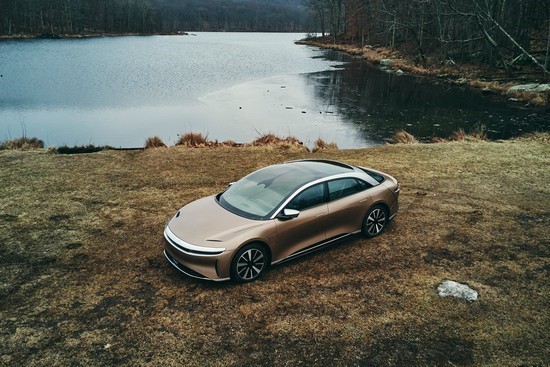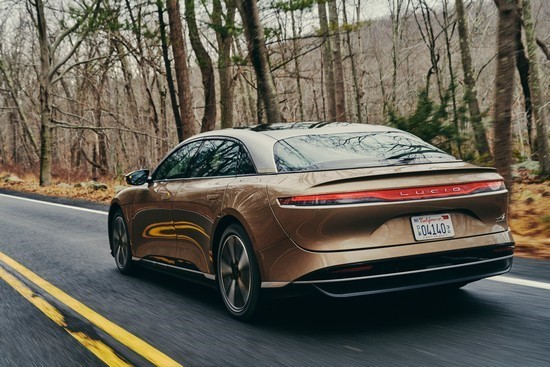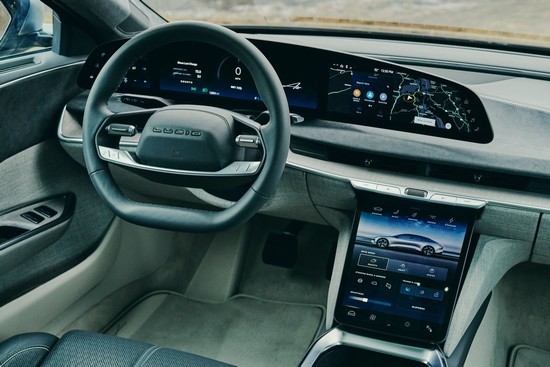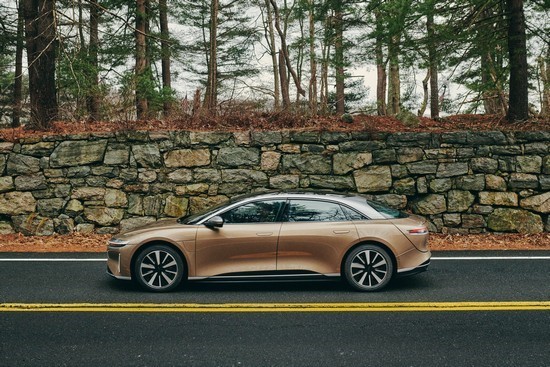Legacy automakers,
facing years of unkind comparisons with a boom-timey
Tesla, have fallen back on
a defensive refrain: Just you wait.
اضافة اعلان
The spin is that, once these slumbering Atlases
get off the mat, their global heft and know-how will let them flood showrooms
with electric vehicles — and narrow the gap with Tesla, which claimed 936,000
sales worldwide in 2021.
Yet it is two
California startups that have just
begun delivering the past year’s most significant new EVs, the Lucid Air, and
the Rivian R1T pickup. And a comparison test of Lucid’s sedan against the 2022
Mercedes-Benz EQS — the first all-electric sedan from the company that
essentially invented the automobile in the late
19th century — favors a
divergent view: A century-plus of experience in building internal-combustion
cars doesn’t necessarily mean squat. Not when automobiles are being digitized
and revolutionized, and new generations of drivers aren’t always impressed by
old names and ways.
 (Photo: NYTimes)
(Photo: NYTimes)
As for which company holds the more relevant
institutional knowledge, consider Lucid’s founder,
Peter Rawlinson: He was the
engineering brains behind Tesla’s world-changing Model S.
The record-smashing 840km driving range he has
coaxed out of the Air is only Exhibit A for his company’s superior in-house
tech and all-in electric approach.
Mercedes, which intends to sell a lineup of
EQ-badged models alongside similarly styled gasoline versions, must serve two
sets of customers while keeping regulators at bay. It must develop a new car
business meant to put its old one out of business. That’s a tough nut to loosen
for the smartest legacy makers.
For traditional automakers, Rawlinson said, the
care and feeding of gasoline cash cows does create some dichotomy. That said,
electric ambivalence is rapidly being swept away.
“You’ve got a clarity of purpose in being a
purely electric car company,” he acknowledged. “Yet there are hardly any
leaders of traditional car companies today who would argue that electric is
anything but the future.”
Like Volkswagen and its ID.4, Mercedes has
played up the EQS as one of the most important cars in its storied history.
Mercedes may yet crack the EV code, but the EQS seems destined to be a footnote.
The EQS drives beautifully, as you would expect
of any six-figure Mercedes, from wizardly rear-wheel steering to what must be
the quietest cabin of any EV yet. But too much EQS tech is showboating gadgetry
that might be applied to any gasoline car, like its overwrought 56-inch Hyperscreen
display and ambient lighting that pours from every crevice, in 64 selectable
colors. What’s missing is any innovation that advances electric driving.
 (Photo: NYTimes)
(Photo: NYTimes)
First impressions don’t help. The EQS’ inelegant
styling adheres to that most played-out of EV tropes: the ovum-shaped
transportation pod, blown up to Benzian proportions. Mercedes posits the EQS as
an alternative to its S-Class flagship; yet taller adults find their noggins
squashed in a cramped back seat, and there’s no storage “frunk” as in many engine-free
EVs. The Lucid is 11 inches shorter, yet easily fits lanky rear-seat riders,
and brings the industry’s largest frunk.
Mercedes says the EQS is the world’s most
aerodynamic production car. But Lucid’s Air is virtually as slippery, and
manages to look great. Despite its aero profile, the EQS has a range maxing out
at 560km, per its government rating. The Lucid’s most efficient version can go
about 50 percent farther, enough for about two and a half more hours of highway
driving.
Put up against Mercedes’ dynastic heritage and
scale,
Lucid is an obscure underdog. Yet this blank-slate company has advanced
EV tech where it counts: No electric has gone farther on a charge. And no EV
has charged faster, adding up to 480km in 20 minutes on a 350-kilowatt charger.
(The Benz’s fastest charging rate is 200 kilowatts.)
 (Photo: NYTimes)
(Photo: NYTimes)
“We just got 500 miles (800km) of range at 70mph
(112km/h) — how did we do that?” Rawlinson said, referring to a real-world,
highway-speed range test conducted by InsideEVs.com. “We did it by taking a
ground-up review of what was possible from an EV.”
Among models tested at the same 70-mph clip, the
compact Tesla Model 3 was a distant second at 500km, followed by Tesla’s Model
S at 480km and the Porsche Taycan at 297. InsideEVs has yet to test the
Mercedes, although my mileage suggested the Benz can meet or exceed its 560km
official rating.
Lucid is also primed to sell many more Airs in
America this year — as many as 20,000 from a new Arizona factory — than the
EQS. Mercedes sold 443 EQS cars in the US in the fourth quarter, although that
initial trickle might ramp up; the company won’t reveal how many will reach
American showrooms this year.
The Air’s tour de force is Rawlinson’s signature
drive unit. The V-8 engine in a new Corvette makes 495 horsepower. With an
eight-speed transmission, the powertrain weighs more than 800 pounds. Lucid’s
powder keg — including an electric motor, single-speed transmission and
inverter — spools up to 650 horsepower and weighs 163 pounds. The entire unit
fits in an airline carry-on bag. And it nearly triples the power density, or
horsepower per pound, of Tesla’s best.
For the German competition, I drove an EQS 580
with 516 horsepower and a 4.1-second dash to 60mph. This EQS (from $120,105, or
$135,300 with options) felt swift — until the
Lucid Air Dream Performance
whisked me away with 1,111 ridiculous horsepower from its dual motors. The
number reads like a misprint, and feels like tripping out a Cessna’s door
without a parachute. That included a free fall down the shoulders of Storm King
Mountain on US Route 9W, the wintry narrows of the Hudson River going blurry
below.
 (Photo: NYTimes)
(Photo: NYTimes)
The Air’s five-year odyssey to showrooms has
dimmed its power to surprise. But its clean, Citroën-like silhouette — with a
dramatic “glass canopy” capping an interior feast of nappa leather, wood and
metal — still looks fresh. The Air satisfies big-screen dreams as well, but its
displays complement the interior rather than overwhelm it.
This Dream Edition’s 520-car run is built and
spoken for, so no need to choke on the $170,500 price. A Grand Touring model
($140,500) amasses 800 horses and 830km of range.
For more apples-to-apples, Mercedes’ rear-drive
EQS 450+ starts at $103,360, with 329 horsepower. For $96,500, Lucid’s Air
Touring brings all-wheel drive and nearly double the
Benz’s horsepower, at 620.
(Deduct a $7,500 federal tax credit from these prices.) The most-affordable Air
Pure, expected late this year, combines a projected 650km range and 480 horses
for $78,900.
The Lucid and the Mercedes are their makers’
opening bids in EV sedans. But where a legacy maker like Mercedes can afford to
tinker and dabble a while longer — perhaps deliberately, buying critical time —
Lucid and Rawlinson have no such luxury. For Lucid, everything is riding on the
Air. And it shows.
Read more Drive



